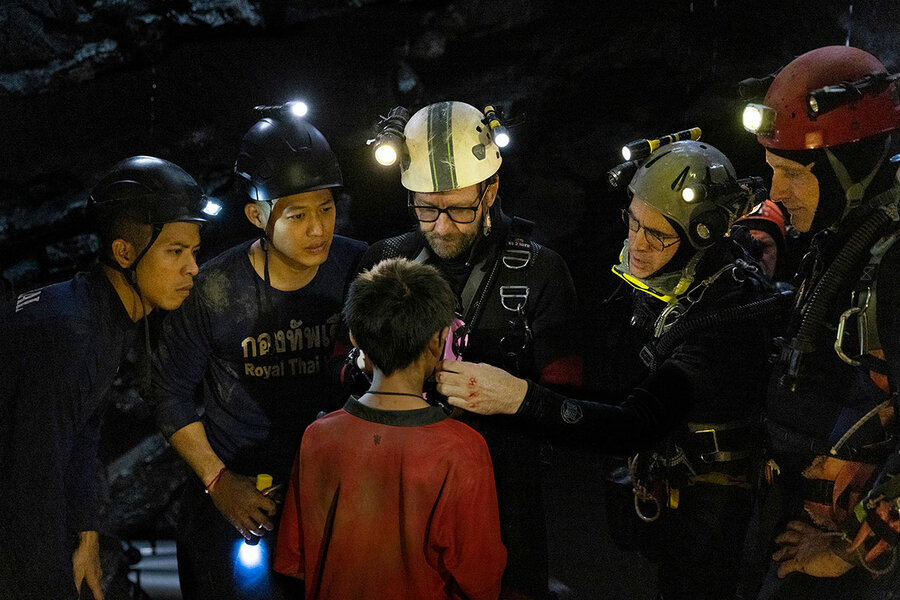For Thai cave rescue, world came together. ‘Thirteen Lives’ shows how.
Loading...
It’s extremely difficult to make a suspenseful movie based on actual events when the outcome to those events is already well known. The details have to be so resonant and revelatory that we forget we already know how everything ends up.
Ron Howard has directed some solid achievements in this realm, notably “Apollo 13,” which dramatized the aborted 1970 moon mission. Now there’s “Thirteen Lives,” starring Viggo Mortensen and Colin Farrell, about the 2018 rescue of 12 Thai junior soccer players and their coach, who were trapped for 18 days inside a mountain cave system rapidly filling up with rainwater during an unexpected monsoon. The news event captivated the world and also brought together rescuers from 17 countries – some 10,000 volunteers, including over 100 divers. Two Thai divers, one an active Navy SEAL, died.
Unavoidably, it was also an event tailor-made for the movies, particularly since all 13 were rescued alive. To the credit of Howard and his screenwriter, William Nicholson, the Hollywood hokum factor in “Thirteen Lives” is fairly low. They understand that this story doesn’t need juicing; it just needs to be well told.
Why We Wrote This
A story focused onHow do you make a suspenseful film about actual events when the outcome is already known? Ron Howard, who has some experience with that, offers a new movie that features tension and courage while respecting the real-life people it depicts.
The sense of premonitory dread sets in early, as the boys, ages 11 to 16, and their coach leave practice on their bicycles to explore the nearby Tham Luang cave as part of an impromptu birthday celebration for one of the players. It would not be until nine days later, on July 2, that two British cave-diving experts, crusty Rick Stanton (Mortensen) and laid-back John Volanthen (Farrell), first contacted them, emaciated but game, huddled on an elevated rock some 2 1/2 miles from the cave’s mouth.
Howard, who has also worked extensively in recent years as a documentarian (“Pavarotti,” “Rebuilding Paradise,” “The Beatles: Eight Days a Week – The Touring Years”), keeps things moving by focusing on the facts. The timelines and maps of the operation are unfussily inserted into the narrative; we always know what progress is, or is not, being made. And despite the widespread assumption that the rescue exemplified the best in the human spirit, the film details a sizable amount of political infighting, particularly early on, between the local governor (sensitively played by Sahajak Boonthanakit) and his higher-ups, and between the Thai SEALs and the foreign divers. Along with their prayers, the local community and the families of the trapped boys also share their frenzied exasperation with the slowness of the operation. (Adding to the authenticity, virtually all of the Thai actors speak in their native dialect, which is subtitled.)
Despite all this, “Thirteen Lives,” depicted from multiple points of view, remains a story of overwhelming humanitarian sacrifice. In some ways, the most moving moment in the film for me came not when the boys are rescued but earlier, when the local farmers are told that in order to divert water from the mountain, their crops – their livelihood – will be ruined in the resulting flood. Their decision is swift and unequivocal: Save our boys.
Given that both Mortensen and Farrell have charisma to spare, they fit remarkably well into the film’s quasi-documentary scheme. So does Joel Edgerton, who plays Richard “Harry” Harris, the Australian anesthesiologist and cave diver who joins forces with Stanton and Volanthen. These actors understand that they are not the true stars of this story – Howard is careful not to play them up as white saviors – and their low-key verisimilitude acknowledges that fact.
I would have wished for a bit more backstory on the lives of these men, or the soccer players, for that matter, who are barely characterized. And an entire movie could be made about the errant commercial exploitation that followed in the wake of the rescue, in which government officials directed the boys’ public relations. None of that is touched on here. But the film succeeds where it counts most. Howard has described the movie as the “anatomy of a miracle,” and that’s indeed what it is.
Peter Rainer is the Monitor’s film critic. “Thirteen Lives” will be in theaters for a limited time starting July 29 and streams on Amazon Prime Video starting Aug. 5. The film is rated PG-13 for some strong language and unsettling images.






